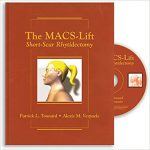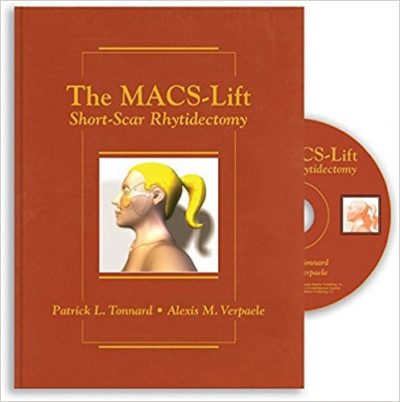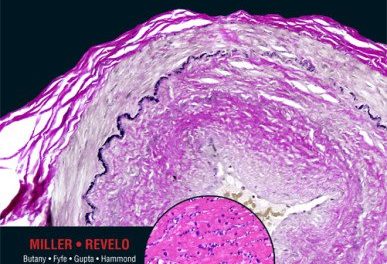 Authors: Patrick L. Tonnard, MD and Alexis M. Verpaele, MD
Authors: Patrick L. Tonnard, MD and Alexis M. Verpaele, MD
Publisher: CRC Press – 285 pages
Book Review by: Nano Khilnani
Rhytidectomy is a medical term for a facelift. It comes from the Greek words rhytis for wrinkle and ektome for excision. This is an increasingly popular type of cosmetic surgery done for the purpose of enabling the patient to have a more youthful facial appearance.
Statistics from a 2011 report by the American Society of Aesthetic Surgery show that facelifts were the sixth most popular aesthetic surgical procedure performed, after: liposuction, breast augmentation, abdominoplasty (tummy tuck), blepharoplasty (eyelid surgery) and breast lift.
There are many types of facelifts, including: the composite facelift, the deep-plane facelift, the endoscopic facelift, the MACS (Minimal Access Cranial Suspension) facelift, the mid facelift, the mini facelift, the skin-only facelift, the SMAS (Superficial Musculo-Aponeurotic System) facelift, the subperiosteal facelift, the thread lift, and volumetric reshaping.
Our initial check of Wikipedia articles on the MACS facelift revealed that this type of facelift allows for the correction of sagging facial features through a short, minimal incision, elevating them vertically by suspending them from above.
There are many advantages to having a MACS facelift versus a traditional facelift. For starters, the MACS-lift uses a shorter scar that is in front of the ear, instead of behind, which is much easier to hide. Overall, the MACS-lift surgery is safer because less skin is raised. This means that there is less risk of bleeding and nerve damage.
The operation also takes less time, lasting 2.5 hours instead of the 3.5 hours that the traditional facelift requires. There is also a shorter recovery period – two to three weeks, instead of three to four weeks. Finally, the results of the MACS-lift are very natural while the traditional facelift will often result in a “windswept” look.
There is an increasing interest in procedures that result in fewer complications, smaller scars, reduced operative time to complete, and shorter recoveries.
This book about the MACS facelift provides a lot of detailed information. We present an overview of what is covered in it by naming the titles of its six chapters below. You can check out sources of more information in the Bibliography portion of the book.
Introduction: The History and Evolution of Rhytidectomy
- Basic Principles and Rationale
- Patient Selection
- Operative Procedure: Clinical Case Presentation
- Case Examples: Surgical Plans and Operative Results
- Secondary and Ancillary Procedures
- Problems and Complications
Bibliography
Surgical Pearls
Index
A DVD is attached on the inside back cover of this book.
This book provides a good balance of text describing how the steps of each of the procedures are performed, and before-and-after photos of patients who underwent the procedures in the MACS-Lift. Let us take a look within chapter 1, Basic Principles and Rationale. These are the topics discussed in this chapter:
- Evolution of the MACS-Lift
- Advantages of the MACS-Lift Technique
- General Principles of MACS-Lifting
- The Simple MACS- Lift
- The Extended MACS-Lift
- Why It Works
- The Evolution from Simple to Extended MACS-Lifting
- Development of the Principle of Pinch Lower Blepharoplasty
- Why the MSCS-Lift Is Not An S-Lift
- The Third Suture
- Improving the Scar: The Horizontal Limb f the Scar
- Improving the Scar: The Vertical Limb f the Scar
- MACS-Lifting: The Limits
- The Anterior Neck
- The Posterior Neck
- The Forehead
This is an excellent book on the unique MACS-Lift, a facelift procedure that needs essentially a minimal incision that lifts facial features, carries less risk of bleeding and nerve damage, takes less time to perform than other types of facelifts, requires a shorter recovery period, and results in a naturally younger look. This is a practical guide written in simple, clear language, that is easy to understand and follow.
Authors:
Patrick L. Tonnard, MD is Assistant Clinical Professor in the Department of Plastic Surgery at Gent University Hospital; and Director of Coupure Centrum Voor Plastiche Chirugie in Gent, Belgium.
Alexis M. Verpaele, MD is Assistant Clinical Professor in the Department of Plastic Surgery at Gent University Hospital; and Director of Coupure Centrum Voor Plastiche Chirugie in Gent, Belgium.
Illustrator:
Kurt Drubbel – silicoN imagE







